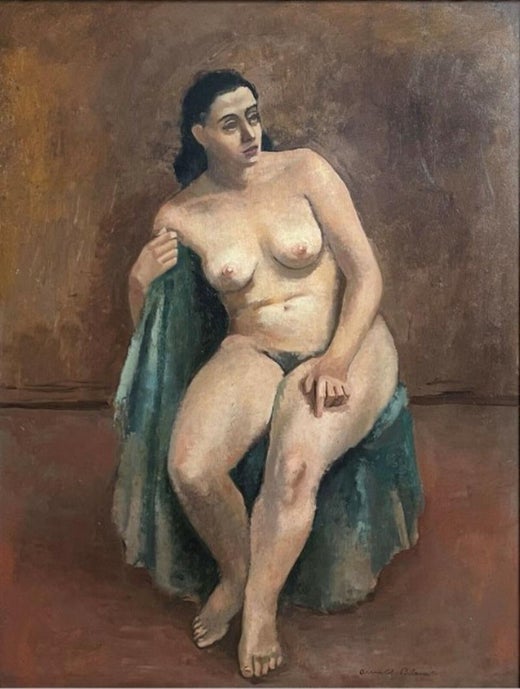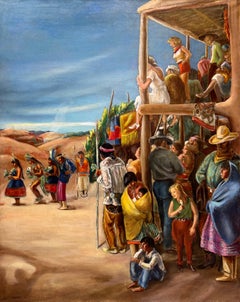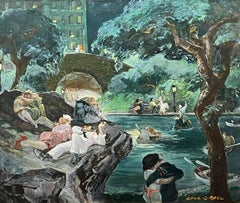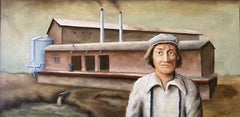Want more images or videos?
Request additional images or videos from the seller
1 of 5
Arnold BlanchThe People1938
1938
$16,000List Price
About the Item
- Creator:Arnold Blanch (1896-1968, American)
- Creation Year:1938
- Dimensions:Height: 36 in (91.44 cm)Width: 48 in (121.92 cm)Depth: 2 in (5.08 cm)
- More Editions & Sizes:36 x 48 inchesPrice: $16,000
- Medium:
- Movement & Style:
- Period:
- Condition:
- Gallery Location:Los Angeles, CA
- Reference Number:1stDibs: LU1859214757332
Arnold Blanch
Born in Mantorville, Minnesota, Arnold Blanch was a painter of scenes of social-realist American life with mystical overtones and a child-like seeming style. He was also a highly respected teacher, lecturer and visiting critic and was a spokesman for the art colony in Woodstock, New York. He was married to Lucile Blanch. Unlike many of his generation, he seemed disinterested in avant-garde styles and held to his own approach with canvases that were happy and somewhat romantic in subject matter. In the 1930s, he was a muralist for the Federal Art Project and did work in post offices in Fredonia, New York and Norwalk, Connecticut. He first studied at the Minneapolis School of Arts, and from 1921 to 1922 was at the Art Students League in New York City, studying with Kenneth Hayes Miller, John Sloan, and Robert Henri. He also studied with Boardman Robinson, whose invitation he accepted to teach in Colorado Springs at the Colorado Fine Arts Center school. He took seriously their assertions that an artist should paint from his own experiences and environment. He was a member of the American Artists Congress, the Association of American Artists, the American Watercolor Society, and the Painters, Sculptors, Gravers Society of America, which he also served as president.
About the Seller
5.0
Vetted Professional Seller
Every seller passes strict standards for authenticity and reliability
1stDibs seller since 2022
17 sales on 1stDibs
Authenticity Guarantee
In the unlikely event there’s an issue with an item’s authenticity, contact us within 1 year for a full refund. DetailsMoney-Back Guarantee
If your item is not as described, is damaged in transit, or does not arrive, contact us within 7 days for a full refund. Details24-Hour Cancellation
You have a 24-hour grace period in which to reconsider your purchase, with no questions asked.Vetted Professional Sellers
Our world-class sellers must adhere to strict standards for service and quality, maintaining the integrity of our listings.Price-Match Guarantee
If you find that a seller listed the same item for a lower price elsewhere, we’ll match it.Trusted Global Delivery
Our best-in-class carrier network provides specialized shipping options worldwide, including custom delivery.You May Also Like
Before the Deluge, Republican Headquarters before Landon lost to Roosevelt.
Located in Marco Island, FL
In 1936, Alfred Landon and Frank Knox were the Republican candidates for President and Vice President. They were defeated in a landslide by Franklin Roosevelt. Clyde Singer captures ...
Category
1930s American Realist Figurative Paintings
Materials
Oil, Canvas
Bill Bally Blacksmithing- American Scene. Americana Bicycle Minnesota
Located in Marco Island, FL
American life is captured in this Clyde Singer painting, Bill Bally Blacksmithing (1987), where he depicts a woman riding her bicycle by a historic and quintessential Minnesota busin...
Category
1980s American Realist Figurative Paintings
Materials
Oil, Canvas
$11,000
H 29 in W 25 in D 2 in
Industrial Railroad WPA Mid 20th Century American Scene Rural Modern Realism
By Louis Bosa
Located in New York, NY
Industrial Railroad WPA Mid 20th Century American Scene Rural Modern Realism
Large oil on canvas genre painting depicting laborers working on a railroad, with rural landscape in the...
Category
1940s American Realist Figurative Paintings
Materials
Canvas, Oil
$11,500
H 29 in W 35 in D 3 in
"Summer Pier Fishing" American Scene Social Realism WPA Mid-20th Century Modern
Located in New York, NY
"Summer Pier Fishing" American Scene Social Realism WPA Mid-20th Century Modern
Syd J. Browne (1907-1991)
"Summer Pier Fishing"
22 x 30 inches
Oil on canvas. c. 1930s
Signed lower r...
Category
1930s American Realist Figurative Paintings
Materials
Canvas, Oil
Morning Beneath the EL NYC American Scene WPA Modern 20th Century Social Realism
By Bernard Gussow
Located in New York, NY
"Morning Beneath the EL" NYC American Scene Ashcan WPA Modern 20th Century Social Realism
Bernard Gussow (1881-1957)
"Morning Beneath the EL"
24 1/4 x 30 inches
Oil on canvas
Signed...
Category
1930s American Realist Figurative Paintings
Materials
Canvas, Oil
NYC EL American Scene Social Realism Mid 20th Century Modern WPA Era Figurative
By Cecil Crosley Bell
Located in New York, NY
NYC EL American Scene Social Realism Mid 20th Century Modern WPA Era Figurative
Cecil Bell (1906 – 1970)
Street Life Under the EL
22 x 30 inches
Oil on canvas, c. 1930s
Signed upper...
Category
1930s American Realist Landscape Paintings
Materials
Canvas, Oil
Columbus Avenue NYC c. 1920s/30s American Scene Ashcan WPA Modern 20th Century
By Bernard Gussow
Located in New York, NY
Columbus Avenue NYC c. 1920s/30s American Scene Ashcan WPA Modern 20th Century
"Late Afternoon, Columbus Avenue, New York", impasto oil on canvas, signed lower left, signed verso (under relining, shown in photo), and titled verso on stretcher, in maple mitered cove frame, 23 1/4" x 27 1/4", SS: 19 1/4" x 23 1/4", Relined.
BIO
Russian-born Gussow trained at the Art Students League and the National Academy of Design. He also studied under Bonnat at the Ecole des Beaux-Arts in Paris. His first claim to fame was exhibiting two works at the Armory Show in 1913. Gussow exhibited at the Society of Independent Artists between 1917 and 1934 and at Salons of America in the 1930s.
The Whitney Museum of American Art, for example, has his Subway Stairs. The Barnes Foundation...
Category
1920s American Realist Figurative Paintings
Materials
Canvas, Oil
UNION SQUARE Depression Era Oil Painting WPA Realism American Scene Realism NYC
By Jo Cain
Located in New York, NY
UNION SQUARE Depression Era Oil Painting WPA Realism American Scene Realism NYC
Jo Cain (1904 – 2003)
"Union Square"
24 x 36 inches
Oil on canvas, c.1940s
S...
Category
1940s American Realist Figurative Paintings
Materials
Canvas, Oil
$33,000
H 31 in W 43 in D 2 in
Street of the Old Quarter British School signed Cade oil on canvas painting
Located in Barcelona, Barcelona
**Technical Sheet**
**Title:** "Street of the Old Quarter"
**Author:** British School, 19th Century
**Date:** 1892
**Technique:** Oil on canvas
**Dimensions:** 14.17 x 10.63 inc...
Category
1890s American Realist Figurative Paintings
Materials
Canvas, Oil
$842 Sale Price
41% Off
H 14.18 in W 10.63 in
"Double Shadow", Oil Painting
By Hazel Z Weckbach
Located in Denver, CO
Kevin Weckbach's (US based) "Double Shadow" is an original, hand made oil painting that depicts a busy city avenue filled with throngs of bundled walkers casting long shadows on the ...
Category
2010s American Realist Landscape Paintings
Materials
Oil, Canvas
More From This Seller
View AllIndian Dance
Located in Los Angeles, CA
Indian Dance, 1935, oil on canvas, signed and dated lower left, 30 x 24, label verso reads: “A Kutka / Indian Dance”, title and artist’s name inscribed verso together with number “12...
Category
1930s American Realist Landscape Paintings
Materials
Canvas, Oil
World War II Invades Central Park
By Cecil Crosley Bell
Located in Los Angeles, CA
World War II Invades Central Park, 1943, oil on canvas, signed lower right, 30 x 36 inches, literature: Barton, Phyllis, Cecil C. Bell, McGrew Color Graphics (Kansas City, MO, 1976),...
Category
1940s American Realist Landscape Paintings
Materials
Canvas, Oil
Factory Worker
Located in Los Angeles, CA
This painting is part of our exhibition America Coast to Coast: Artists of the 1930s
Factory Worker, c. 1936, oil on canvas, signed lower right, 18 ¼ x 36 inches; exhibited in City ...
Category
1930s American Realist Figurative Paintings
Materials
Oil
Knight’s Lodging
Located in Los Angeles, CA
This painting is part of our exhibition American Coast to Coast: Artists of the 1930s
Knight’s Lodging, 1941, oil on canvas panel, signed and dated lower left, 16 x 20 inches, exhi...
Category
1940s American Realist Figurative Paintings
Materials
Oil
Industry and Commerce
Located in Los Angeles, CA
This mural study is part of our exhibition America Coast to Coast: Artists of the 1930s
Industry and Commerce, 1936, tempera on panel, 16 ½ x 39 ½ inches, signed verso “John Ballator, Portland Ore.” provenance includes: J.C. Penney Company, represented by Russell Tether Fine Arts Assoc.; presented in a newer wood frame
About the Painting
Industry and Commerce is a prime example of WPA Era muralism. Like a Mediaeval alter, this mural study is filled with icons, but the images of saints and martyrs are replaced with symbols of America's gospel of prosperity through capitalism. Industry and Commerce has a strong narrative quality with vignettes filling the entire surface. Extraction, logistics, design, power generation, and manufacturing for printing, chemicals, automobiles and metal products are all represented. To eliminate any doubt about the mural's themes, Ballator letters a description into the bottom of the study. Ballator also presents an idealized version of industrial cooperation, as his workers, lab-coated technicians and tie-wearing managers work harmoniously toward a common goal in the tidy and neatly designed environments. Although far from the reality of most industrial spaces, Ballator's study reflects the idealized and morale boosting tone that many mural projects adopted during the Great Depression.
About the Artist
John R Ballator achieved success as a muralist, lithographer, and teacher during the Great Depression. Born in Oregon, he studied at the Portland Museum Art School, the University of Oregon and at Yale University where he received a Bachelor of Fine Art. In 1936, Ballator was commissioned to paint a mural panel for the new Department of Justice Building in Washington DC, an important project that spanned five years with several dozen artists contributing a total of sixty-eight designs. Ballator completed murals for the St. Johns Post Office and Franklin High School, both in Portland, Oregon. He also contributed to the 1938 murals at Nathan Hale School in New Haven, Connecticut. During the late 1930s, Ballator taught art for several years at Washburn College in Topeka, Kanas, where he completed a mural for the Menninger Arts & Craft Shop before accepting a professorship at Hollins College...
Category
1930s American Realist Figurative Paintings
Materials
Tempera
Circus Wagons
By Millard Sheets
Located in Los Angeles, CA
This watercolor is part of our exhibition America Coast to Coast: Artists of the 1930s
Circus Wagons, 1927, watercolor on paper, signed and dated lower left, 10 x19 ¾ inches (sight), provenance includes Stary-Sheets Art Gallery (Gualala, CA); J. Ralph & Louis Stone Foundation; presented in a newer metal frame behind glazing
About the Painting
Millard Sheets was only twenty years old and in his third year of studies at the Chouinard Art Institute when he painted Circus Wagons. Despite his youth, Sheets was already an accomplished artist who had publicly exhibited his work and won prestigious prizes. Within several years, he would have his first solo exhibition at one of Los Angeles’ premiere galleries and become a painting instructor at his alma mater. In Circus Wagons we already see Sheets deft handling of the watercolor medium and his interest in the California Scene. In this case, Sheets captures a back lot view of a traveling circus, a subject he sometimes returned to, including in a color screen print in the collection of the National Gallery. Sheets made a career by painting what he knew and observed firsthand. This approach allowed Sheets to capture with authenticity the details of each narrative. Even with a narrowly limited palette and an economy of brushstrokes, Sheets effectively depicts the southern California scene with its strong and mysterious shadows, as well as the workers and circus animals. Seen through the hindsight of his six-decade long career, Circus Wagons offers a fascinating insight into the early development of California Scene painting which would by the mid-1930s become the best recognized style on the West Coast.
About the Artist
Millard Sheets was the dean of California watercolorists. His list of accomplishments is so extensive that his entry in Who was Who in American Art is over forty lines. Born in Pomona, California, Sheets became a painter at an early age, winning a prize at the Los Angeles County Fair in 1918. By the mid to late-1920s, Sheets became a regular at art exhibitions in the western part of the United States, winning several additional prizes before he reached the age of twenty-five. Sheets studied at the prestigious Chouinard Art Institute from 1925 through 1929 with Frank Tolles Chamberlin and Clarence Hinkle and had his first solo show with Los Angeles’ Dalzell Hatfield Gallery in 1929. During the 1930s, Sheets was invited to exhibit at almost every major American Museum and in many ways, his work came to represent the California watercolor school...
Category
1920s American Realist Figurative Paintings
Materials
Watercolor




